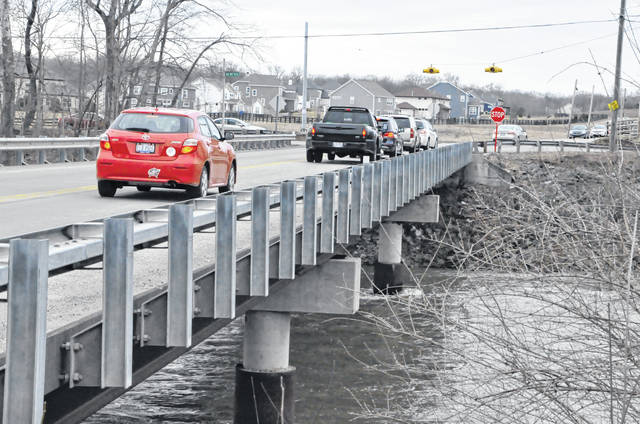
According to the Delaware County Engineer’s Office, the widening of the Home Road bridge at state Route 315 will have environmental impacts that will need to be mitigated.
“We are impacting a little over half an acre of wetland as part of the project,” Delaware County Chief Deputy Engineer Rob Riley told the Board of Commissioners during its Monday session. “Various permits require that we mitigate and offset the impact by purchasing credit. There is a program in the Big Darby Watershed where we can purchase credit for about six-tenths of an acre at a cost of $33,000.”
Commissioner Barb Lewis asked Riley how long have the mitigation regulations been in force.
“It’s been about 10-15 years as part of the Clean Water Act,” he said. “Anytime you impact a waterway, there are various permits that kick in. One of those is a federal permit that is administrated by the Corps of Army Engineers. There is also a newer requirement of the Ohio EPA (Environmental Protection Agency) which anytime you impact a stream or waterway, you’re also required to mitigate it.”
Riley said linear impacts to the stream add up quickly and tend to be the most costly of the permits.
“I know that we pay this firm S&W (Stream and Wetland Foundation) $33,000, but what do they actually do with it?” asked Commissioner Jeff Benton.
Riley said the foundation works with the Ohio EPA to find and purchase acreage with good wetland features elsewhere to create a wetland mitigation bank to offset the area lost due to the construction.
According to Delaware County Engineer Chris Bauserman, the county has partnered with Preservation Parks of Delaware County in the past to create wetland easements within the county. He said the land purchased by the county becomes part of the parks system.
“The requirements continue to become more stringent,” Riley said. “We find ourselves having to delay projects because we can’t find suitable mitigation, and the mitigation that is available is very costly.”
Riley said the stream impact regulations are a recent change that causes some “consternation.” He said the Clean Water Act regulates the impacts below the ordinary high waterline.
“There is a permit to mitigate below the waterline,” he said. “There is another for a buffer along a stream.”
Riley said the Ohio EPA regulates the vegetation around the stream. He said in order to prevent contaminants from getting into the stream, the Ohio EPA wants a “vegetative state” along each side at a specified distance from the edge of the stream.
“I won’t sugar coat it,” Riley said. “The unfortunate reality is that it comes at a great cost in terms of dollars and time to go through the process.”
Lewis said she wonders what happens in counties that don’t have the resources that Delaware County does.
“It’s a real issue,” Riley said. “There is an individual permit associated with the Olentangy Watershed that you don’t have to go through that level of mitigation with other watersheds. We know regulations don’t go backward, and they get harder and harder.”
Back in November 2018, commissioners signed off on the widening of Home Road at the intersection of state Route 315, which will add additional lanes to handle the increase in traffic that has resulted in backups, especially during peak hours.
Riley said the project has been in the works for over six years. He said the widening would add extra lanes in both directions on Home Road and a traffic light.
“Because of the way that intersection is aligned, we’ll have to rebuild the west leg of the intersection,” Riley said in November. “However, we were fortunate when the subdivision to the west was built, because they dedicated right-of-way to accommodate the future road.”
He added the project has an estimated price tag of $8.5 million, and the work will begin with widening the bridge on Home Road that spans the Olentangy River.
“We’ll have to rebuild the existing bridge to widen it,” he said. “We will have to close the road (east of the intersection at the bridge) for five to six months during construction of the bridge. The west leg (of Home Road) and (state Route) 315 will remain open during that time frame, but not as bad as closing the whole intersection. Unfortunately, there’s just no way to do what we need to do while maintaining traffic.”
Bauserman said the project is expected to begin in July.


